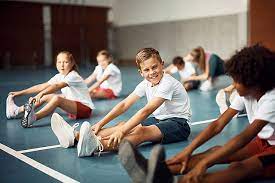
Physical Education (PE) is often seen as a break from academic subjects, but it plays a crucial role in a child’s overall development. Regular participation in PE can significantly boost both the body and mind, contributing to healthier and more well-rounded individuals.
The Physical Benefits of PE
Building Stronger Bodies
One of the most immediate benefits of PE is its impact on physical health. Regular exercise during PE classes helps children develop stronger muscles and bones, improve cardiovascular health, and maintain a healthy weight. Activities like running, jumping, and playing sports increase endurance and flexibility, laying the foundation for a healthy lifestyle.
See Here:
Preventing Childhood Obesity
With the rise in sedentary lifestyles and poor eating habits, childhood obesity has become a major concern. PE classes provide structured opportunities for children to engage in physical activities that help burn calories and build muscle. This, in turn, can prevent obesity and the related health problems, such as diabetes and heart disease, later in life.
The Mental Benefits of PE
Enhancing Cognitive Function
Physical activity isn’t just good for the body; it also benefits the brain. Studies have shown that regular exercise can improve cognitive function, leading to better concentration, memory, and problem-solving skills. This boost in brain function can translate into improved academic performance, as children are better able to focus and retain information in the classroom.
Reducing Stress and Anxiety
PE classes also provide an outlet for children to relieve stress and reduce anxiety. Physical activity triggers the release of endorphins, which are natural mood lifters. Participating in sports and games helps children manage their emotions, build resilience, and develop a positive outlook on life. This mental health benefit is especially important in today’s fast-paced and pressure-filled world.
Social and Emotional Development
Promoting Teamwork and Cooperation
PE classes are not just about individual fitness; they also teach valuable social skills. Through team sports and group activities, children learn the importance of teamwork, cooperation, and fair play. These experiences help them develop communication skills, build friendships, and understand the value of working together to achieve common goals.
Building Confidence and Self-Esteem
Success in physical activities can greatly enhance a child’s self-esteem. Whether it’s mastering a new skill, winning a game, or simply improving their performance, these achievements build confidence. Children learn to set goals, face challenges, and take pride in their accomplishments, all of which contribute to a positive self-image.
The Long-Term Impact of PE
Establishing Lifelong Healthy Habits
The habits formed during childhood often carry into adulthood. PE classes instill the importance of regular physical activity, helping children develop a lifelong commitment to fitness and health. By fostering a positive attitude toward exercise, PE can lead to healthier lifestyles that persist well beyond school years.
Preparing for a Balanced Life
Finally, PE classes teach children the importance of balancing physical, mental, and social well-being. By integrating physical activity into their daily routine, children learn to prioritize their health, manage stress, and maintain a balanced life. These lessons are essential for navigating the challenges of adulthood.
Conclusion
Physical Education is far more than just a break from academics; it is a vital component of a child’s education. By boosting physical health, enhancing cognitive function, and promoting social and emotional development, PE classes contribute to the overall well-being of children. Investing in quality PE programs is an investment in the future, ensuring that children grow up to be healthy, happy, and well-rounded individuals.





